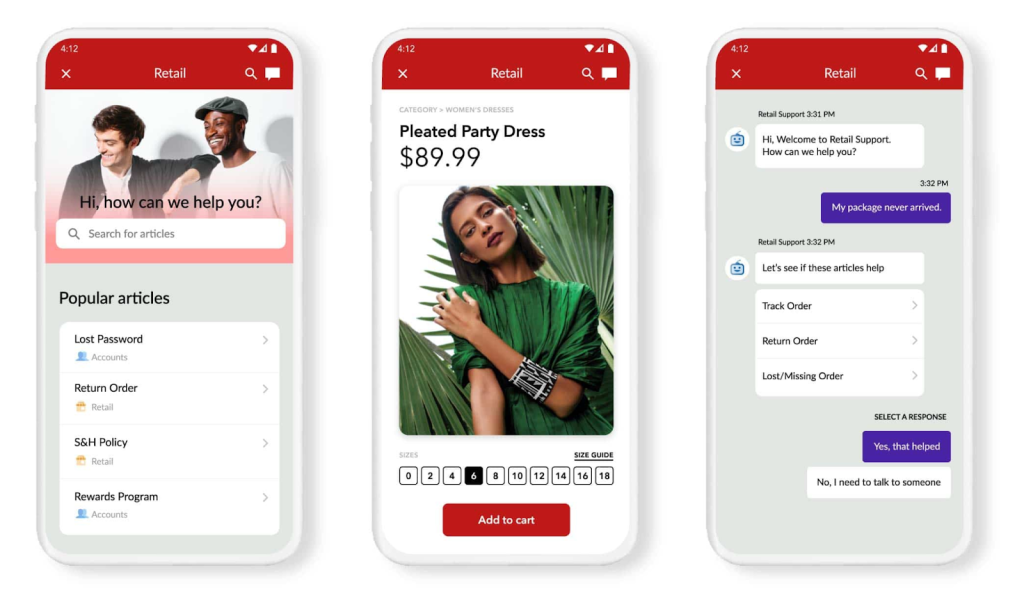In today’s dynamic business landscape, providing exceptional customer service isn’t just a good practice; it’s a strategic imperative. With the advent of digitalization and the evolving preferences of consumers, companies are constantly challenged to not only meet but exceed customer expectations across a multitude of channels seamlessly. This is where omnichannel customer service emerges as a transformative approach. In this exhaustive guide, we’ll delve deep into the realm of omnichannel customer service, exploring its nuances, benefits, strategies, challenges, and real-world examples.
What is Omnichannel Customer Service?
Omnichannel customer service is a holistic approach to customer support that integrates multiple communication channels into a unified and seamless experience. Unlike traditional multichannel customer service, where channels operate independently, omnichannel service aims to provide a consistent and integrated experience across all touchpoints, including but not limited to phone calls, emails, live chat, social media platforms, mobile applications, and in-person interactions.
What is Omnichannel Customer Communication?
Omnichannel customer communication extends beyond transactional interactions to encompass relationship-building and brand storytelling. It involves crafting compelling narratives, sharing valuable content, and fostering meaningful connections with customers across multiple touchpoints. By delivering relevant and engaging communication, businesses can strengthen customer relationships and drive brand loyalty over time.
The Difference between Multichannel and Omnichannel Customer Service
While multichannel customer service involves offering support through various channels, omnichannel service takes it a step further by ensuring a synchronized and cohesive experience across those channels. In multichannel service, channels may operate in silos, leading to disjointed interactions and inconsistent information. Omnichannel service, on the contrary, seamlessly connects these channels, allowing customers to transition between them effortlessly while maintaining context and continuity.
Benefits of Omnichannel Customer Service
- Enhanced Customer Experience. Omnichannel service provides customers with unparalleled flexibility and convenience, allowing them to interact with brands on their preferred channels and devices. From researching products online to seeking assistance via live chat or phone, customers enjoy a seamless journey.
- Improved Customer Loyalty. By offering personalized and consistent support experiences, businesses can foster stronger relationships with customers, leading to increased loyalty and retention. Customers appreciate the convenience and reliability of omnichannel service, which encourages repeat purchases and referrals.
- Increased Operational Efficiency. Streamlining customer interactions across channels can help businesses optimize resources, reduce response times, and enhance productivity. With integrated systems and workflows, companies can efficiently manage customer inquiries and resolve issues promptly.
- Better Insights and Analytics. Omnichannel platforms enable businesses to gather invaluable data and insights across multiple touchpoints, empowering them to make data-driven decisions and continually enhance service quality. By analyzing customer interactions and preferences, companies can tailor their offerings and marketing strategies to better meet customer needs.
Omnichannel Customer Service Strategy: 12 Steps
Implementing an effective omnichannel customer service strategy requires careful planning, coordination, and execution. Here are 12 steps that will help you unlock the full potential of your customer service approach.
1. Define Your Customer Journey
Map out the various touchpoints and channels your customers use to interact with your brand throughout their journey. Understand their preferences, pain points, and expectations at each stage.
2. Integrate Your Channels
Invest in technology and systems that facilitate seamless integration and communication between channels. Implement a centralized customer relationship management (CRM) system to consolidate customer data and interactions.
3. Personalize the Experience
Leverage data and customer insights to personalize interactions and tailor solutions to individual needs effectively. Use customer segmentation and behavior analysis to deliver relevant content and recommendations across channels.
4. Empower Your Agents
Equip your customer service team with the requisite tools, training, and autonomy they need to deliver exceptional support across channels. Provide comprehensive training on product knowledge, communication skills, and problem-solving techniques.
5. Monitor and Measure Performance
Continuously monitor key metrics and gather feedback to identify areas for improvement and optimization. Track metrics such as response time, resolution rate, customer satisfaction scores, and Net Promoter Score (NPS).
6. Adapt and Evolve
Stay agile and responsive to changing customer preferences and emerging technologies, continually refining your omnichannel strategy to stay ahead of the curve. Embrace innovation and experimentation to anticipate future trends and customer needs.
7. Harness Data Analytics
Utilize advanced analytics tools to extract actionable insights from customer interactions across channels. Analyzing customer behavior, preferences, and feedback can help refine marketing strategies, personalize offerings, and anticipate future needs.
8. Invest in Automation
Implement intelligent automation solutions, such as chatbots and self-service portals, to handle routine inquiries and transactions efficiently. Automation can help reduce response times, improve scalability, and free up human agents to focus on more complex issues.
9. Cultivate a Customer-Centric Culture
Foster a culture of customer centricity and empathy throughout your organization. Encourage cross-departmental collaboration and alignment around the common goal of delivering exceptional customer experiences.
10. Embrace Continuous Improvement
Continuously evaluate and iterate on your omnichannel strategy based on customer feedback, market trends, and technological advancements. Stay agile and adaptable in response to changing customer needs and competitive dynamics.
11. Customer Feedback and Iteration
Actively solicit and incorporate customer feedback into your omnichannel strategy. Conduct surveys, monitor social media mentions, and leverage customer reviews to identify pain points and areas for improvement. Use insights gathered from customer feedback to iterate and optimize your omnichannel approach continuously.
12. Community Building and Engagement
Foster a sense of community among your customers by creating online forums, social media groups, and user communities where they can connect, share experiences, and provide support to one another. Encourage active participation and engagement to build brand advocacy and loyalty.
Omnichannel Customer Service Examples and Use Cases
- Amazon. With features like “Buy Online, Pickup In-Store” and seamless integration between its website, app, and Alexa-enabled devices, Amazon epitomizes a seamless omnichannel shopping experience. Customers can browse products, make purchases, and track orders seamlessly across channels.
- Starbucks. The Starbucks mobile app allows customers to order ahead, pay, and earn rewards across various channels, including mobile, web, and in-store, enhancing convenience and customer satisfaction. The app also integrates with the Starbucks loyalty program, providing personalized offers and recommendations.
- Disney. Disney’s MagicBand technology enables guests to access attractions, make payments, and personalize their experiences seamlessly across Disney parks and resorts, setting a new standard for immersive customer engagement. Guests can plan their itinerary, reserve FastPasses, and interact with attractions using the MagicBand, creating a magical and memorable experience.
- Apple. Apple offers a seamless omnichannel experience across its retail stores, website, and customer service hotline. Customers can schedule appointments at Apple stores, seek technical support online, or contact customer service via phone or live chat, ensuring consistent and personalized assistance across channels.
- Uber. Uber provides a convenient and integrated customer experience through its app, allowing users to request rides, track driver locations, and make payments seamlessly. With features like in-app messaging and real-time support, Uber ensures prompt assistance and resolution of customer issues across channels.
Omnichannel Customer Service Challenges
- Integration Complexity: integrating disparate systems and channels can pose significant challenges, requiring substantial investment in technology and infrastructure. Companies must ensure seamless data flow and interoperability between systems to provide a unified customer experience.
- Data Silos and Fragmentation: fragmented data across channels can impede visibility and insights, making it challenging to comprehend and anticipate customer needs accurately. Businesses must centralize and standardize data collection and analysis processes to gain a comprehensive view of customer interactions and preferences.
- Consistency and Quality Control: maintaining consistency in messaging, branding, and service quality across channels necessitates meticulous coordination and governance. Companies must establish clear guidelines and protocols for communication and customer interactions to ensure uniformity and professionalism.
- Employee Training and Alignment: ensuring that frontline staff are equipped with the requisite skills and knowledge to deliver consistent and high-quality service across channels is imperative but can be resource-intensive. Companies must invest in comprehensive training programs and ongoing support to empower employees to excel in their roles and exceed customer expectations. Technology Integration and
- Maintenance: maintaining seamless integration between disparate systems and platforms requires ongoing investment in technology infrastructure and maintenance. Companies must stay abreast of technological advancements and industry best practices to ensure the smooth functioning of their omnichannel ecosystem.
- Regulatory Compliance and Data Privacy: ensuring compliance with data protection regulations and safeguarding customer privacy is paramount in omnichannel customer service. Companies must adhere to stringent data privacy laws and implement robust security measures to protect sensitive customer information across channels.
- Cultural and Organizational Alignment: achieving alignment across departments and organizational silos is essential for delivering a cohesive omnichannel experience. Companies must foster a culture of collaboration and accountability, with clear communication channels and shared goals, to ensure consistency and coherence across all customer touchpoints.
- Customer Expectations and Innovation: meeting evolving customer expectations and staying ahead of the competition requires continuous innovation and adaptation. Companies must anticipate emerging trends, embrace new technologies, and proactively seek opportunities to delight and surprise customers across channels.
Conclusion
In conclusion, mastering omnichannel customer service is an ongoing journey that requires dedication, innovation, and a customer-centric mindset. By adopting a holistic approach and addressing the challenges and opportunities inherent in omnichannel engagement, businesses can create memorable experiences, build lasting relationships, and drive sustainable growth in today’s digital age.




